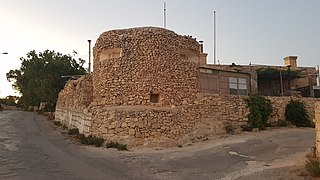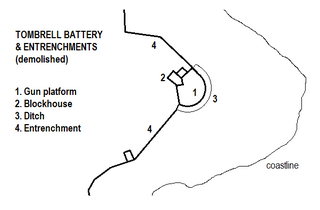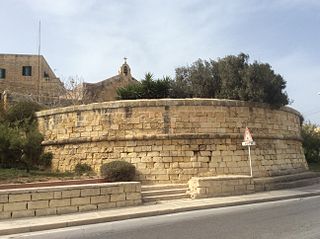
Fort San Lucian, also known as Saint Lucian Tower or Fort Rohan, is a large bastioned watchtower and polygonal fort in Marsaxlokk, Malta. The original tower was built by the Order of Saint John between 1610 and 1611, being the second of six Wignacourt towers.

Fort Tas-Silġ is a polygonal fort in Marsaxlokk, Malta. It was built between 1879 and 1883 by the British on high ground at the shoreward end of Delimara Point, above il-Ħofra-ż-Żgħira. Its primary function was as a fire control point controlling the massed guns of Fort Delimara on the headland below.

Saint Paul's Battery, also known as Ta' Lombardi Battery, is an artillery battery in Marsaxlokk, Malta. It stands on high ground at the shoreward end of Delimara Point, above il-Ħofra-z-Zgħira. It is a polygonal fort and was built by the British from 1881 to 1886. It commands a field of fire northwards over St Thomas' Bay and Marsaskala.

Saint Mary's Battery, also known as Comino Battery, is an artillery battery on the island of Comino in Malta. It was built by the Order of Saint John between 1715 and 1716 as one of a series of fortifications around the coasts of the Maltese Islands.

San Rocco Battery was an artillery battery in Kalkara, Malta, built by Maltese insurgents during the French blockade of 1798–1800. It was the last in a chain of batteries, redoubts and entrenchments encircling the French positions in Marsamxett and the Grand Harbour. It was built to control the entrance to the harbour as well as the French occupied Fort Ricasoli. The battery was continually being fired upon by the French at Fort Ricasoli, which was located about 700 m (2,300 ft) away.

Vendôme Tower is a tour-reduit in Marsaxlokk, Malta. It was built by the Order of Saint John in 1715 as one of a series of fortifications around the coasts of the Maltese Islands. It is the only surviving tour-reduit in Malta. Today, Vendôme Tower houses the headquarters of Marsaxlokk F.C.

Wolseley Battery is an artillery battery in Delimara, Marsaxlokk, Malta. It was built by the British between 1897 and 1899, and is located close to Fort Tas-Silġ. Today, the battery still exists, but it is not accessible to the public.

Tombrell Battery was an artillery battery in Delimara, Marsaxlokk, Malta. It was built in around 1722 by the Order of Saint John as one of a series of coastal fortifications around the coasts of the Maltese Islands. The battery was demolished at the end of the 19th century, and only its rock-hewn ditch survives today.

Ferretti Battery, also known as Qajjenza Battery or Saint George's Battery, is an artillery battery in the village of Qajjenza, within the limits of Birżebbuġa, in Malta. It was built by the Order of Saint John in 1715 and 1716 as one of a series of fortifications around the coasts of the Maltese Islands. A restaurant exists within the walls of the battery, serving Mediterranean cuisine.

Vendôme Battery, also known as Ta' Maċċu Battery, is an artillery battery near Armier Bay, limits of Mellieħa, Malta. It was built by the Order of Saint John in 1715–1716 as one of a series of coastal fortifications around the Maltese Islands.

Wied Musa Battery, also known as Swatar Battery, is a former artillery battery in Marfa, limits of Mellieħa, Malta. It was built by the Order of Saint John in 1714–1716 as one of a series of coastal fortifications around the Maltese Islands.
Fedeau Battery was an artillery battery in Mellieħa, Malta. It was built by the Order of Saint John in 1714-16 as part of a series of coastal fortifications around the Maltese Islands, and demolished in the 20th century.

Riħama Battery is an artillery battery in Marsaskala, Malta. It was built by the Order of Saint John in 1714–1716 as one of a series of coastal fortifications around the coasts of the Maltese Islands. The battery still exists, although it is in a dilapidated state with part of it having collapsed.

Pinto Battery, also known as Għżira Battery or Kechakara Battery, is a former artillery battery in Birżebbuġa, Malta. It was built by the Order of Saint John in 1715 and 1716 as one of a series of coastal fortifications around the coasts of the Maltese Islands. The battery has been heavily altered over time, and the blockhouse now houses a bar and a garage, while the gun platform and parapet have been largely destroyed, with only the general outline still visible.
Għallis Battery, also known as Pondéves Battery, was an artillery battery in Magħtab, within the limits of Naxxar, Malta. It was built in 1715–1716 by the Order of Saint John as one of a series of coastal fortifications around the Maltese Islands. The battery has been mostly ruined, but some debris can still be seen.

Saint George Redoubt is a redoubt in Birżebbuġa, Malta. It was built in 1714–1716 by the Order of Saint John as one of a series of coastal fortifications around the Maltese Islands. It is named after a chapel dedicated to St. George, which was incorporated within the redoubt. The redoubt and chapel still exist and are in good condition.
Del Fango Redoubt, also known as De Vami Redoubt, was a redoubt in Marsaxlokk, Malta. Made of limestone, it was built in 1715–1716 by the Order of Saint John as part of a series of coastal fortifications around the Maltese Islands. An entrenchment was originally located close to the redoubt.
Balbani Battery, also known as Bengħisa Battery or Saint Catherine's Battery, was an artillery battery in Birżebbuġa, Malta. It was built by the Order of Saint John on commands by Grand Master Manuel Pinto da Fonseca and was completed in 1721. The battery was named for Cristoforo Balbani, who partially financed its construction. It was one of a series of coastal fortifications around the Maltese Islands.
Elminiech Battery, also known as Figuella Battery, San Raimondo Battery or Oitelboura Battery, was an artillery battery in Birżebbuġa, Malta. It was built by the Order of Saint John in 1715–16 as part of a series of coastal fortifications around the Maltese Islands.
Saint Mary's Battery, also known as Qolla s-Safra Battery or Gironda Battery, was an artillery battery in Marsalforn, limits of Żebbuġ, Gozo, Malta. It was built by the Order of Saint John in 1715 as one of a series of coastal fortifications around the Maltese Islands.















